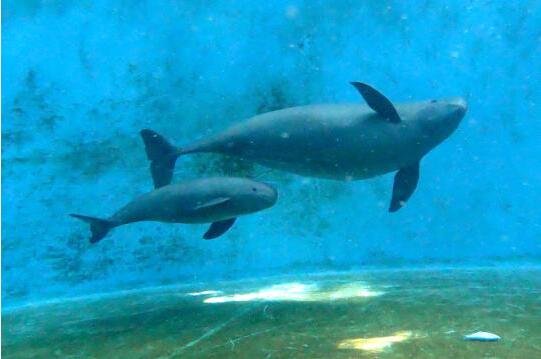
Newsroom
Breeding Project of Endangered Porpoise Sees Success

Finless porpoise F9 and her daughter F9C swim at the Institute of Hydrobiology, Chinese Academy of Sciences, in Wuhan, Hubei Province, last month. (Photo/China Daily)
The world's first captive-bred Yangtze finless porpoise to have a parent that was also born in captivity reached four months old this week, marking a breakthrough in the research on artificial breeding technologies of the endangered species.
The female baby, named F9C-meaning F9's calf-was born at the Institute of Hydrobiology under the Chinese Academy of Sciences in Hubei province on June 11. Its mother F9-short for Fu Jiu, or "long happiness"-is a wild porpoise, while its father Tao Tao, 14, is the world's first finless porpoise bred in captivity.
Researchers studying artificial propagation of the finless porpoise had long been concerned about whether captive-bred porpoises could breed, and whether the mother and baby could build an intimate relationship that is crucial to the baby's survival.
F9C is making great progress, according to Wang Kexiong, a researcher at the institute.
"It is very healthy and active, and has started to chase fish and spit bubbles just 30 days after birth," he said.
Last summer, Tao Tao and F9 successfully mated in the institute thanks to assistant technologies. Ultrasound screening confirmed the healthy growth of the embryo, and scientists prepared a special "mommy diet" for F9 to guarantee sufficient nutrition during pregnancy.
"F9 is quiet and enjoys time alone," Wang said. "Our scientists made a personalized daily exercise plan for her that fit her personality," Wang said.
Because porpoises have a sharp sense of hearing, scientists reduced noise made by machines in F9's pool to create a more pleasant living experience.
"Also, it was arranged so she could spend some time with other mother porpoises and learn parenting skills from them," he said. "The training also helped her to simulate motherly instincts as soon as possible after labor."
F9's labor lasted 150 minutes, according to Wang. The mother and the daughter soon successfully built an intimate relationship.
"Such a relationship is crucial," Wang said. "Without it, some mother porpoises might refuse to feed the baby, which would soon die due to the lack of care and nutrition."
After the birth of F9C, scientists conducted a paternity test, which confirmed Tao Tao is the father. It also proved that captive-bred porpoises can mate with wild ones.
The Yangtze River's finless porpoise, one of the very few porpoise species that live in fresh water, is believed to be endangered. Scientific research on the species released by the Ministry of Agricultural and Rural Affairs in 2018 shows that its population was just 1,012-fewer than that of the giant panda.
The Yangtze River's finless porpoise is found in the main Yangtze River channel in central and eastern China and in two lakes, Dongting and Poyang, which are naturally connected to the river. The porpoise's small size and cute 'smile' make it a much loved animal in China and beyond.
Over the past 40 years, the porpoise's numbers have dramatically declined due to several factors, including climate change and habitat loss, according to Zhang Xinqiao, program manager of the World Wide Fund for Nature in China.
"Although the population of the Yangtze finless porpoise has shown stability in recent years as a result of joint protection from government organs, research institutes and other social organizations, it still faces threats from human activities such as over fishing and water pollution," he said.
"To protect these porpoises, more efforts are needed to preserve healthy rivers and lakes, which many people heavily rely on for food, clean water and livelihoods," Zhang said. (China Daily)